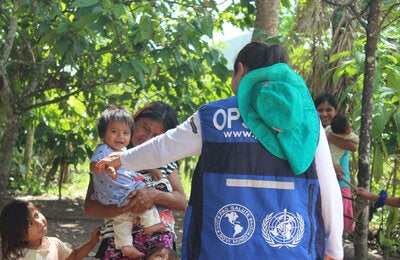
 When envisioning the future of public health in the Americas, we can and should dare to dream of victories that greatly benefit all citizens and have a real impact on the human development levels of our peoples.
When envisioning the future of public health in the Americas, we can and should dare to dream of victories that greatly benefit all citizens and have a real impact on the human development levels of our peoples.
Eliminating certain illnesses or diseases that still afflict our peoples even though we possess the knowledge and tools with which to make them virtually disappear is one of those achievable dreams."
AN ACHIEVABLE DREAM:
Eliminating some Diseases from the Region
 By Mirta Roses-Periago, Director
By Mirta Roses-Periago, Director
Pan American Health Organization
When envisioning the future of public health in the Americas, we can and should dare to dream of victories that greatly benefit all citizens and have a real impact on the human development levels of our peoples.
 Eliminating certain illnesses or diseases that still afflict our peoples even though we possess the knowledge and tools with which to make them virtually disappear is one of those achievable dreams.
Eliminating certain illnesses or diseases that still afflict our peoples even though we possess the knowledge and tools with which to make them virtually disappear is one of those achievable dreams.
Since it is achievable, it is also ethically imperative that we make a determined effort to eliminate those diseases, as I said in my recent address on assuming the office to which I was reelected by the Member States. (Inauguration's Speech)
Of course, achieving so ambitious a goal is no simple matter. Public health strategies for eradicating or eliminating a disease call for specific, intensive interventions--often in the form of campaigns--with rapid response capacity, high standards of performance, continuous monitoring, the definition of geographical areas, and a specific time frame. Political and social commitment, the participation and organization of the affected communities themselves, the availability of resources and international support, and ongoing communication and information are essential for eliminating a disease.
The Region of the Americas has demonstrated, however, that has enormous potential for eradicating and eliminating diseases, as it has proven with the eradication of the wild poliovirus and the elimination of endemic measles. In light of these experiences and the commitment of the Member States, we can set ourselves new goals for old problems.
Here in the Pan American Health Organization we have begun to review the existing data and evidence to determine which diseases can be eliminated or significantly reduced by 2015 at the regional, subregional, or national level.
The preliminary list of diseases identified through this initiative is as follows: leprosy, trachoma, neonatal tetanus, onchocerciasis, vector-borne and transfusion-transmitted Chagas' disease, lymphatic filariasis, congenital syphilis, rubella, and congenital rubella syndrome, rabies transmitted by dogs, and measles. Others could be eliminated as public health problems at the subregional level—for example, malaria in the Caribbean; or the national level—for example, plague or malaria in some countries in Central and South America.
We are making headway in the scientific and political debate that will set the course for this proposal and later permit the mobilization of commitment and resources. This is a fundamental part of our fervent commitment to equity, to reaching the highest attainable standard of health for all with all. As I stated in my inaugural address, the eradication or elimination of those diseases "will be the greatest legacy of our 20th century generation to the children of the 21st century. We cannot fail them! "



